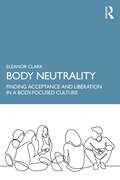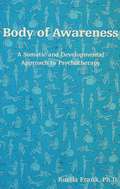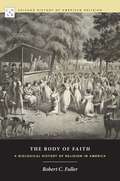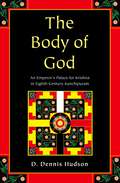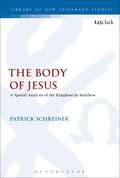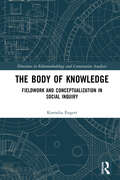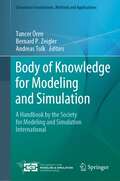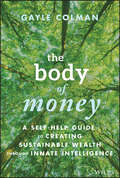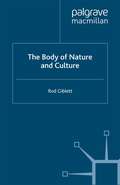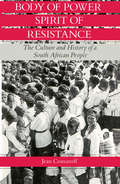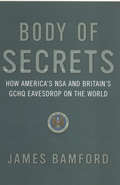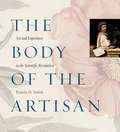- Table View
- List View
Body Neutrality: Finding Acceptance and Liberation in a Body-Focused Culture
by Eleanor ClarkThis practical, accessible book teaches readers how to practice healthy body image habits and let go of an emphasis on body image through research, activities, and personal stories. Body neutrality is a body image approach focused on finding acceptance and liberation from the body-focused culture in which we live. Body neutrality is a shift toward seeing our bodies as a vessel of who we are rather than as who we are. This guide is organized into thirteen chapters, each outlining a different concept of body neutrality ranging from comparison and identity to mindfulness and gratitude, inviting participation from the reader through end-of-chapter activities. For anyone aiming to release the enslaving emphasis placed on appearance in a world where body obsession has become inappropriately “normal,” this book will provide insight and practical guidance toward freedom. Body Neutrality is for anyone struggling with self-esteem and body image issues who aims for acceptance and liberation.
Body of Awareness: A Somatic and Developmental Approach to Psychotherapy
by Ruella FrankMerging scientific theory with a practical, clinical approach, Body of Awareness explores the formation of infant movement experience and its manifest influence upon the later adult. Most significantly, it shows how the organizing principles in early development are functionally equivalent to those of the adult. It demonstrates how movement plays a critical role in a developing self-awareness for the infant and in maintaining a healthy self throughout life. In addition, a variety of case studies illustrates how infant developmental movement patterns are part of the moment-to-moment processes of the adult client and how to bring these patterns to awareness within therapy. Body of Awareness is intended to help therapists, new or advanced, to enhance their skills of attunement. They can do this by heightening their observations of subtle movement patterns as they emerge within the client/therapist relationship, and by respective their own developing feelings within session as essential information to the therapy process. And as developmental patterns are central to psychological functioning, a background study of movement provides the therapist with critical insight into the unfolding psychodynamic field.
Body of Awareness: A Somatic and Developmental Approach to Psychotherapy
by Ruella FrankMerging scientific theory with a practical, clinical approach, Body of Awareness explores the formation of infant movement experience and its manifest influence upon the later adult. Most significantly, it shows how the organizing principles in early development are functionally equivalent to those of the adult. It demonstrates how movement plays a critical role in a developing self-awareness for the infant and in maintaining a healthy self throughout life. In addition, a variety of case studies illustrates how infant developmental movement patterns are part of the moment-to-moment processes of the adult client and how to bring these patterns to awareness within therapy. Body of Awareness is intended to help therapists, new or advanced, to enhance their skills of attunement. They can do this by heightening their observations of subtle movement patterns as they emerge within the client/therapist relationship, and by respective their own developing feelings within session as essential information to the therapy process. And as developmental patterns are central to psychological functioning, a background study of movement provides the therapist with critical insight into the unfolding psychodynamic field.
The Body of Faith: A Biological History of Religion in America (Chicago History of American Religion)
by Robert C. FullerThe postmodern view that human experience is constructed by language and culture has informed historical narratives for decades. Yet newly emerging information about the biological body now makes it possible to supplement traditional scholarly models with insights about the bodily sources of human thought and experience. The Body of Faith is the first account of American religious history to highlight the biological body. Robert C. Fuller brings a crucial new perspective to the study of American religion, showing that knowledge about the biological body deeply enriches how we explain dramatic episodes in American religious life. Fuller shows that the body’s genetically evolved systems—pain responses, sexual passion, and emotions like shame and fear—have persistently shaped the ways that Americans forge relationships with nature, to society, and to God. The first new work to appear in the Chicago History of American Religion series in decades, The Body of Faith offers a truly interdisciplinary framework for explaining the richness, diversity, and endless creativity of American religious life.
The Body of Faith: A Biological History of Religion in America (Chicago History of American Religion)
by Robert C. FullerThe postmodern view that human experience is constructed by language and culture has informed historical narratives for decades. Yet newly emerging information about the biological body now makes it possible to supplement traditional scholarly models with insights about the bodily sources of human thought and experience. The Body of Faith is the first account of American religious history to highlight the biological body. Robert C. Fuller brings a crucial new perspective to the study of American religion, showing that knowledge about the biological body deeply enriches how we explain dramatic episodes in American religious life. Fuller shows that the body’s genetically evolved systems—pain responses, sexual passion, and emotions like shame and fear—have persistently shaped the ways that Americans forge relationships with nature, to society, and to God. The first new work to appear in the Chicago History of American Religion series in decades, The Body of Faith offers a truly interdisciplinary framework for explaining the richness, diversity, and endless creativity of American religious life.
The Body of Faith: A Biological History of Religion in America (Chicago History of American Religion)
by Robert C. FullerThe postmodern view that human experience is constructed by language and culture has informed historical narratives for decades. Yet newly emerging information about the biological body now makes it possible to supplement traditional scholarly models with insights about the bodily sources of human thought and experience. The Body of Faith is the first account of American religious history to highlight the biological body. Robert C. Fuller brings a crucial new perspective to the study of American religion, showing that knowledge about the biological body deeply enriches how we explain dramatic episodes in American religious life. Fuller shows that the body’s genetically evolved systems—pain responses, sexual passion, and emotions like shame and fear—have persistently shaped the ways that Americans forge relationships with nature, to society, and to God. The first new work to appear in the Chicago History of American Religion series in decades, The Body of Faith offers a truly interdisciplinary framework for explaining the richness, diversity, and endless creativity of American religious life.
The Body of Faith: A Biological History of Religion in America (Chicago History of American Religion)
by Robert C. FullerThe postmodern view that human experience is constructed by language and culture has informed historical narratives for decades. Yet newly emerging information about the biological body now makes it possible to supplement traditional scholarly models with insights about the bodily sources of human thought and experience. The Body of Faith is the first account of American religious history to highlight the biological body. Robert C. Fuller brings a crucial new perspective to the study of American religion, showing that knowledge about the biological body deeply enriches how we explain dramatic episodes in American religious life. Fuller shows that the body’s genetically evolved systems—pain responses, sexual passion, and emotions like shame and fear—have persistently shaped the ways that Americans forge relationships with nature, to society, and to God. The first new work to appear in the Chicago History of American Religion series in decades, The Body of Faith offers a truly interdisciplinary framework for explaining the richness, diversity, and endless creativity of American religious life.
The Body of God: An Emperor's Palace for Krishna in Eighth-Century Kanchipuram
by D Dennis HudsonThis book is the crowning achievement of the remarkable scholar D. Dennis Hudson, bringing together the results of a lifetime of interdisciplinary study of south Indian Hinduism. The book is a finely detailed examination of a virtually unstudied Tamil Hindu temple, the Vaikuntha Perumal (ca. 770 C.E.). Hudson offers a sustained reading of the temple as a coherent, organized, minutely conceptualized mandala. Its iconography and structure can be understood in the light of a ten-stanza poem by the Alvar poet Tirumangai, and of the Bhagavata Purana and other major religious texts, even as it in turn illuminates the meanings of those texts. Hudson takes the reader step by step on a tour of the temple, telling the stories suggested by each of the 56 sculpted panels and showing how their relationship to one another brings out layers of meaning. He correlates the stories with stages in the spiritual growth of the king through the complex rituals that formed a crucial dimension of the religion. The result is a tapestry of interpretation that brings to life the richness of spiritual understanding embodied in the temple. Hudson's underlying assumption is that the temple itself constitutes a summa theologica for the Pancharatra doctrines in the Bhagavata tradition centered on Krishna as it had developed through the eighth century. This tradition was already ancient and had spread widely across South Asia and into Southeast Asia. By interweaving history with artistic, liturgical, and textual interpretation, Hudson makes a remarkable contribution to our understanding of an Indian religious and cultural tradition.
The Body of Jesus: A Spatial Analysis of the Kingdom in Matthew (The Library of New Testament Studies #555)
by Patrick SchreinerLittle attention is usually given to the space or place of the kingdom. Yet Matthew employs the distinctive phrase "kingdom of heaven†? and also portrays Jesus as Immanuel (God with us). In this volume Patrick Schreiner argues that by expanding one's view of space one can see that Jesus' purpose is to reorder the space of the earth in Matthew as the heavenly king. Jesus pierces the barrier between the two realms in his incarnation, and the spaces of heaven and earth begin to collide in his ministry. Therefore, in Matthew, Jesus does not just promise a temporal or ethereal kingdom, but one that is located, one that has a sense of rootedness. Jesus is granted authority over this space and inspires people to follow him in this construction project. The spatial kingdom begins in his body, and he extends it to his church by promising his presence.
The Body of Jesus: A Spatial Analysis of the Kingdom in Matthew (The Library of New Testament Studies)
by Patrick SchreinerLittle attention is usually given to the space or place of the kingdom. Yet Matthew employs the distinctive phrase “kingdom of heaven” and also portrays Jesus as Immanuel (God with us). In this volume Patrick Schreiner argues that by expanding one's view of space one can see that Jesus' purpose is to reorder the space of the earth in Matthew as the heavenly king. Jesus pierces the barrier between the two realms in his incarnation, and the spaces of heaven and earth begin to collide in his ministry. Therefore, in Matthew, Jesus does not just promise a temporal or ethereal kingdom, but one that is located, one that has a sense of rootedness. Jesus is granted authority over this space and inspires people to follow him in this construction project. The spatial kingdom begins in his body, and he extends it to his church by promising his presence.
The Body of Knowledge: Fieldwork and Conceptualization in Social Inquiry (Directions in Ethnomethodology and Conversation Analysis)
by Kornelia EngertThis book presents a vivid and close-up view of social science researchers engaged in fieldwork, in discussions with colleagues, and in writing. Adopting an ethnographic approach inspired by ethnomethodology and conversation analysis, the author pursues a praxeological analysis of social inquiry in situ. By conceiving of analytical practices such as observation, shop talk, and conceptualization in experiential terms, the seen but unnoticed structures of knowledge work are exposed and made available for empirical analysis. In a departure from ethnographic studies of research that focus on the physical sciences, the author uses the example of sociological research to shed new light on the role of self and mind for epistemic cultures, on the elusive materiality of conceptual objects, and on researchers’ experiential ways of seizing, reviewing, and accrediting knowledge. A rich and pervasive study of elementary sites in the research process, The Body of Knowledge will appeal to scholars of sociology, anthropology, and the humanities with interests in the epistemic practice of their own discipline, as well as those working in fields such as the social study of science, ethnomethodology and conversation analysis, and the sociology of interaction.
The Body of Knowledge: Fieldwork and Conceptualization in Social Inquiry (Directions in Ethnomethodology and Conversation Analysis)
by Kornelia EngertThis book presents a vivid and close-up view of social science researchers engaged in fieldwork, in discussions with colleagues, and in writing. Adopting an ethnographic approach inspired by ethnomethodology and conversation analysis, the author pursues a praxeological analysis of social inquiry in situ. By conceiving of analytical practices such as observation, shop talk, and conceptualization in experiential terms, the seen but unnoticed structures of knowledge work are exposed and made available for empirical analysis. In a departure from ethnographic studies of research that focus on the physical sciences, the author uses the example of sociological research to shed new light on the role of self and mind for epistemic cultures, on the elusive materiality of conceptual objects, and on researchers’ experiential ways of seizing, reviewing, and accrediting knowledge. A rich and pervasive study of elementary sites in the research process, The Body of Knowledge will appeal to scholars of sociology, anthropology, and the humanities with interests in the epistemic practice of their own discipline, as well as those working in fields such as the social study of science, ethnomethodology and conversation analysis, and the sociology of interaction.
Body of Knowledge for Modeling and Simulation: A Handbook by the Society for Modeling and Simulation International (Simulation Foundations, Methods and Applications)
by Tuncer Ören Bernard P. Zeigler Andreas TolkCommissioned by the Society for Modeling and Simulation International (SCS), this needed, useful new ‘Body of Knowledge’ (BoK) collects and organizes the common understanding of a wide collection of professionals and professional associations.Modeling and simulation (M&S) is a ubiquitous discipline that lays the computational foundation for real and virtual experimentation, clearly stating boundaries—and interactions—of systems, data, and representations. The field is well known, too, for its training support via simulations and simulators. Indeed, with computers increasingly influencing the activities of today’s world, M&S is the third pillar of scientific understanding, taking its place along with theory building and empirical observation.This valuable new handbook provides intellectual support for all disciplines in analysis, design and optimization. It contributes increasingly to the growing number of computational disciplines, addressing the broad variety of contributing as well as supported disciplines and application domains. Further, each of its sections provide numerous references for further information. Highly comprehensive, the BoK represents many viewpoints and facets, captured under such topics as:Mathematical and Systems Theory FoundationsSimulation Formalisms and ParadigmsSynergies with Systems Engineering and Artificial IntelligenceMultidisciplinary ChallengesEthics and PhilosophyHistorical PerspectivesExamining theoretical as well as practical challenges, this unique volume addresses the many facets of M&S for scholars, students, and practitioners. As such, it affords readers from all science, engineering, and arts disciplines a comprehensive and concise representation of concepts, terms, and activities needed to explain the M&S discipline.Tuncer Ören is Professor Emeritus at the University of Ottawa. Bernard Zeigler is Professor Emeritus at the University of Arizona. Andreas Tolk is Chief Scientist at The MITRE Corporation. All three editors are long-time members and Fellows of the Society for Modeling and Simulation International. Under the leadership of three SCS Fellows, Dr. Ören, University of Ottawa, Dr. Zeigler, The University of Arizona, and Dr. Tolk, The MITRE Corporation, more than 50 international scholars from 15 countries provided insights and experience to compile this initial M&S Body of Knowledge.
The Body of Money: A Self-Help Guide to Creating Sustainable Wealth through Innate Intelligence
by Gayle ColmanIn a world gone mad with money The Body of Money: A Self-Help Guide to Create Sustainable Wealth through Innate Intelligence is a comprehensive guide to building and sustaining wealth by using the incredible intelligence of the human body. The story you’ve been told about money is all wrong. Spreadsheets, PNL’s, money markets, and index funds only touch the surface. The Body of Money provides a completely unique and effective approach to personal finance like nothing you’ve experienced before. By demystifying money psychology and behavior economics Certified Financial Planner® and Master Integral Coach™ Gayle Colman shows you exactly how to use your innate wisdom to heal old money patterns, tend to wounds created by generational financial trauma and create sustainable wealth that is aligned with your deepest values. Integrating cutting-edge research, laugh-out-loud storytelling and body-centered practices, Gayle puts the power of individual wealth–building squarely back in your own hands. You will learn: How body practices can have a transformative effect on your money habits. Where your personal money manager lives in your body and how to access its true wisdom. Why investing in a way that matches your personal values can actually be better for your health. How to use your body to gain true financial agency, reduce debt, invest in real estate and make the most important money decisions of your life. The Body of Money is an indispensable approach to personal finance, perfect for any person seeking relief from money struggles and all individuals and families who want to create a robust and healthy money legacy for their lives.
The Body of Money: A Self-Help Guide to Creating Sustainable Wealth through Innate Intelligence
by Gayle ColmanIn a world gone mad with money The Body of Money: A Self-Help Guide to Create Sustainable Wealth through Innate Intelligence is a comprehensive guide to building and sustaining wealth by using the incredible intelligence of the human body. The story you’ve been told about money is all wrong. Spreadsheets, PNL’s, money markets, and index funds only touch the surface. The Body of Money provides a completely unique and effective approach to personal finance like nothing you’ve experienced before. By demystifying money psychology and behavior economics Certified Financial Planner® and Master Integral Coach™ Gayle Colman shows you exactly how to use your innate wisdom to heal old money patterns, tend to wounds created by generational financial trauma and create sustainable wealth that is aligned with your deepest values. Integrating cutting-edge research, laugh-out-loud storytelling and body-centered practices, Gayle puts the power of individual wealth–building squarely back in your own hands. You will learn: How body practices can have a transformative effect on your money habits. Where your personal money manager lives in your body and how to access its true wisdom. Why investing in a way that matches your personal values can actually be better for your health. How to use your body to gain true financial agency, reduce debt, invest in real estate and make the most important money decisions of your life. The Body of Money is an indispensable approach to personal finance, perfect for any person seeking relief from money struggles and all individuals and families who want to create a robust and healthy money legacy for their lives.
The Body of Nature and Culture
by R. GiblettThis book explores the relationship of human bodies with natural and cultural environments, arguing that these categories are linked and intertwined. It argues for an environmentally sustainable and healthy relationship between the body and the earth.
Body of Power, Spirit of Resistance: The Culture and History of a South African People
by Jean ComaroffIn this sophisticated study of power and resistance, Jean Comaroff analyzes the changing predicament of the Barolong boo Ratshidi, a people on the margins of the South African state. Like others on the fringes of the modern world system, the Tshidi struggle to construct a viable order of signs and practices through which they act upon the forces that engulf them. Their dissenting Churches of Zion have provided an effective medium for reconstructing a sense of history and identity, one that protests the terms of colonial and post-colonial society and culture.
Body of Power, Spirit of Resistance: The Culture and History of a South African People
by Jean ComaroffIn this sophisticated study of power and resistance, Jean Comaroff analyzes the changing predicament of the Barolong boo Ratshidi, a people on the margins of the South African state. Like others on the fringes of the modern world system, the Tshidi struggle to construct a viable order of signs and practices through which they act upon the forces that engulf them. Their dissenting Churches of Zion have provided an effective medium for reconstructing a sense of history and identity, one that protests the terms of colonial and post-colonial society and culture.
Body of Power, Spirit of Resistance: The Culture and History of a South African People
by Jean ComaroffIn this sophisticated study of power and resistance, Jean Comaroff analyzes the changing predicament of the Barolong boo Ratshidi, a people on the margins of the South African state. Like others on the fringes of the modern world system, the Tshidi struggle to construct a viable order of signs and practices through which they act upon the forces that engulf them. Their dissenting Churches of Zion have provided an effective medium for reconstructing a sense of history and identity, one that protests the terms of colonial and post-colonial society and culture.
Body of Power, Spirit of Resistance: The Culture and History of a South African People
by Jean ComaroffIn this sophisticated study of power and resistance, Jean Comaroff analyzes the changing predicament of the Barolong boo Ratshidi, a people on the margins of the South African state. Like others on the fringes of the modern world system, the Tshidi struggle to construct a viable order of signs and practices through which they act upon the forces that engulf them. Their dissenting Churches of Zion have provided an effective medium for reconstructing a sense of history and identity, one that protests the terms of colonial and post-colonial society and culture.
Body Of Secrets: Anatomy Of The Ultra-secret National Security Agency
by James BamfordThe NSA is the largest, most secretive and most powerful intelligence agency in the world. With a staff of 38,000 people, it dwarfs the CIA in budget, manpower and influence. Recent headlines have linked it to economic espionage throughout Europe and to the ongoing hunt for the terrorist leader Osama bin Laden. James Bamford first penetrated the wall of silence surrounding the NSA in 1982, with the much-talked-about US bestseller THE PUZZLE PALACE. In BODY OF SECRETS he offers shocking new details about the inner workings of the agency, gathered through unique access to thousands of internal documents and interviews with current and former officials. Unveiling extremely sensitive information for the first time, Bamford exposes the role the NSA played in numerous Soviet bloc Cold War conflicts and discusses its undercover involvement in the Vietnam War. His investigation into the NSA's technological advances during the last 15 years brings to light a network of global surveillance ranging from on-line listening posts to sophisticated intelligence-gathering satellites. In a hard-hitting conclusion, he warns the NSA is a double-edged sword: while its worldwide eavesdropping activities offer the potential for tracking down terrorists and uncovering nuclear weapons deals, it also has the capacity to listen in on global personal communications.
The Body of the Artisan: Art and Experience in the Scientific Revolution
by Pamela H. SmithSince the time of Aristotle, the making of knowledge and the making of objects have generally been considered separate enterprises. Yet during the late sixteenth and early seventeenth centuries, the two became linked through a "new" philosophy known as science. In The Body of the Artisan, Pamela H. Smith demonstrates how much early modern science owed to an unlikely source-artists and artisans. From goldsmiths to locksmiths and from carpenters to painters, artists and artisans were much sought after by the new scientists for their intimate, hands-on knowledge of natural materials and the ability to manipulate them. Drawing on a fascinating array of new evidence from northern Europe including artisans' objects and their writings, Smith shows how artisans saw all knowledge as rooted in matter and nature. With nearly two hundred images, The Body of the Artisan provides astonishingly vivid examples of this Renaissance synergy among art, craft, and science, and recovers a forgotten episode of the Scientific Revolution-an episode that forever altered the way we see the natural world.
The Body of the Artisan: Art and Experience in the Scientific Revolution
by Pamela H. SmithSince the time of Aristotle, the making of knowledge and the making of objects have generally been considered separate enterprises. Yet during the late sixteenth and early seventeenth centuries, the two became linked through a "new" philosophy known as science. In The Body of the Artisan, Pamela H. Smith demonstrates how much early modern science owed to an unlikely source-artists and artisans. From goldsmiths to locksmiths and from carpenters to painters, artists and artisans were much sought after by the new scientists for their intimate, hands-on knowledge of natural materials and the ability to manipulate them. Drawing on a fascinating array of new evidence from northern Europe including artisans' objects and their writings, Smith shows how artisans saw all knowledge as rooted in matter and nature. With nearly two hundred images, The Body of the Artisan provides astonishingly vivid examples of this Renaissance synergy among art, craft, and science, and recovers a forgotten episode of the Scientific Revolution-an episode that forever altered the way we see the natural world.
The Body of the Artisan: Art and Experience in the Scientific Revolution
by Pamela H. SmithSince the time of Aristotle, the making of knowledge and the making of objects have generally been considered separate enterprises. Yet during the late sixteenth and early seventeenth centuries, the two became linked through a "new" philosophy known as science. In The Body of the Artisan, Pamela H. Smith demonstrates how much early modern science owed to an unlikely source-artists and artisans. From goldsmiths to locksmiths and from carpenters to painters, artists and artisans were much sought after by the new scientists for their intimate, hands-on knowledge of natural materials and the ability to manipulate them. Drawing on a fascinating array of new evidence from northern Europe including artisans' objects and their writings, Smith shows how artisans saw all knowledge as rooted in matter and nature. With nearly two hundred images, The Body of the Artisan provides astonishingly vivid examples of this Renaissance synergy among art, craft, and science, and recovers a forgotten episode of the Scientific Revolution-an episode that forever altered the way we see the natural world.
The Body of the Artisan: Art and Experience in the Scientific Revolution
by Pamela H. SmithSince the time of Aristotle, the making of knowledge and the making of objects have generally been considered separate enterprises. Yet during the late sixteenth and early seventeenth centuries, the two became linked through a "new" philosophy known as science. In The Body of the Artisan, Pamela H. Smith demonstrates how much early modern science owed to an unlikely source-artists and artisans. From goldsmiths to locksmiths and from carpenters to painters, artists and artisans were much sought after by the new scientists for their intimate, hands-on knowledge of natural materials and the ability to manipulate them. Drawing on a fascinating array of new evidence from northern Europe including artisans' objects and their writings, Smith shows how artisans saw all knowledge as rooted in matter and nature. With nearly two hundred images, The Body of the Artisan provides astonishingly vivid examples of this Renaissance synergy among art, craft, and science, and recovers a forgotten episode of the Scientific Revolution-an episode that forever altered the way we see the natural world.
